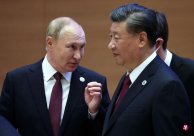The Federal Reserve raised 75 basis points overnight, the RMB exchange rate fell, and the domestic and foreign exchange rates fell to 7.10 yuan.Since the day of the day, the lower limit of the exchange rate fluctuation range of the intermediate price of 2%of the weak prescription was further approached.
According to Bloomberg, in the face of the Fed's eagle position, mainland China continued to respond to the mid -price price against the US dollar with obvious biased RMB.Although the middle price of the RMB against the US dollar was weakened on Thursday (22nd), it was still 850 points stronger than market expectations. The 21st days were significantly stronger.Statistics have been recorded since.
At 11:15 Beijing time, the shores fell 0.64%to 7.0931 yuan, and the offshore RMB fell 0.39%to 7.1026 yuan; the real -time CFETS index simulated by Bloomberg fell 0.22%to 101.07.
The intermediate price reported at 6.9798 on Thursday, and the predicted average of 13 institutions was 7.0648 yuan.Based on the medium price of 2%, today's exchange rate allows the fluctuation range to be from 6.8402 to 7.1194 yuan.
Zhang Jiantai, the chief foreign exchange strategist of Ruisui Bank Asia, said: "The middle price can only slow down the rhythm of the RMB depreciation. If you want to keep 7 at the middle price, then the 2%fluctuation interval represents the lower limit of the depreciation of the depreciation of 7.14."The depreciation of a wave of RMB is mainly driven by the dollar; if the offshore depreciation continues and the price on the shore can stabilize, arbitrage transactions can also narrow the price difference.
In the early morning of Thursday, the Federal Reserve raised 75 basis points for the third time. Chairman Powell also delivered a eagle speech. The post -tightening policy position was firm than expected.The two -year US debt yield rose overnight to the highest level in 2007, and the Bloomberg US dollar index rose to a high point since 2005.
Eddie Cheung, a senior emerging market strategist in Dongfang Huili in Hong Kong, said that the middle price itself has appeared since late August., Instead of the depreciation of the exchange rate, "The gap between the period and the middle price will be closer to 2%, especially considering that there will be other central bank resolutions to bring volatility today."
The Bank of Japan maintainsAfter the policy interest rate unchanged, the yen fell below 145 for the first time since 1998.Today, the central bank's interest rate resolution will also be ushered in, and the Bank of England will expected to raise interest rates by 50 base points to 2.25%.
The Greater China stock market fell on Thursday morning. The Hong Kong stocks Hang Seng Index fell by more than 2%, falling below the March low of this year. It moved to a new low of more than ten years. The Hang Seng Technology Index also fell more than 3%.The A -share CSI 300 Index has fallen by about 1%, and the Shanghai Composite Index has lost 3,00 points, but the index is still showing toughness in the three places markets.The Taiwan stock index fell the largest number of more than a week.



